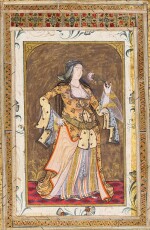
AN ODALISQUE, STYLE OF LEVNI, TURKEY, OTTOMAN, FIRST QUARTER 18TH CENTURY
Auction Closed
October 23, 04:16 PM GMT
Estimate
5,000 - 7,000 GBP
Lot Details
Description
AN ODALISQUE, STYLE OF LEVNI, TURKEY, OTTOMAN, FIRST QUARTER 18TH CENTURY
gouache heightened with gold on paper
painting: 15.7 by 9.5cm.
leaf: 31.2 by 21cm.
Christie’s London, 13 April 2010, lot 259.
This standing portrait of a female figure belongs to a tradition popular in the first half of the eighteenth century of representing story characters in a single portrait. Albums with such figures were put together with the precise aim of providing a visual aid to the audience while the story was narrated. This portrait of an elderly plump woman is almost the mirror image of a painting now in the Topkapi Palace Museum (inv.no.H.2164) representing a plump lady holding a carnation (f.8b, illustrated in Irepoglu 1999, p.159).
The whole album was painted by one of the most celebrated painters of the Tulip Period, Abdülcelil Celebi Levni. Levni was active at the Ottoman court, under the patronage of Sultan Mustafa II (r.1695-1703) and Ahmed III (r.1703-30) and was renowned for his delicate and lively manner of depicting single figures, detaching himself from the static and more classical early seventeenth-century style of Ottoman portraiture.
